
Hugh d'Avranches, nicknamed le Gros or Lupus, was from 1071 the second Norman Earl of Chester. and one of the great magnates of early Norman England.

Bec Abbey, formally the Abbey of Our Lady of Bec, is a Benedictine monastic foundation in the Eure département, in the Bec valley midway between the cities of Rouen and Bernay. It is located in Le Bec Hellouin, Normandy, France, and was the most influential abbey of the 12th-century Anglo-Norman kingdom.
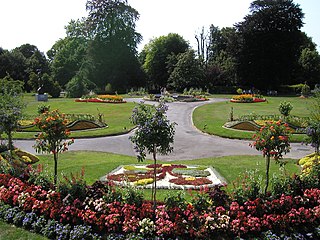
Avranches is a commune in the Manche department in the Normandy region in northwestern France. It is a subprefecture of the department. The inhabitants are called Avranchinais.

William de Warenne, 2nd Earl of Surrey was the son of William de Warenne, 1st Earl of Surrey and his first wife Gundred. He was more often referred to as Earl Warenne or Earl of Warenne than as Earl of Surrey.
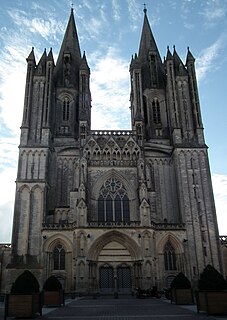
Geoffrey de Montbray, bishop of Coutances, also known as Geoffrey of Coutances, was a Norman nobleman, trusted adviser of William the Conqueror and a great secular prelate, warrior and administrator.
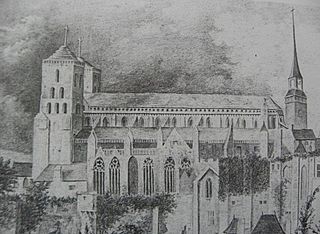
Avranches Cathedral was once a Roman Catholic cathedral in Avranches in Normandy.
John of Avranches was bishop of Avranches from 1060 to 1067, and archbishop of Rouen from 1067 to 1079. He was a Norman churchman, son of Rodulf of Ivry, and brother of Hugh of Bayeux. He appears in the Gesta Normannorum Ducum of William of Jumièges, and may have been one of the sources William used.
Ranulf le Meschin, 3rd Earl of Chester (1070−1129) was a Norman magnate based in northern and central England. Originating in Bessin in Normandy, Ranulf made his career in England thanks to his kinship with Hugh d'Avranches - the Earl of Chester, the patronage of kings William II Rufus and Henry I Beauclerc, and his marriage to Lucy, heiress of the Bolingbroke-Spalding estates in Lincolnshire.

Souvigny Priory, in the commune of Souvigny, Allier, France, in the centre of the old province of the Bourbonnais, was formerly a Cluniac priory, of which the church remains in operation.

The Domesday Book of 1086 lists in the following order the tenants-in-chief in Devonshire of King William the Conqueror:
Transamund III was the Duke of Spoleto and Marquis of Camerino from 982 until his death in 989.
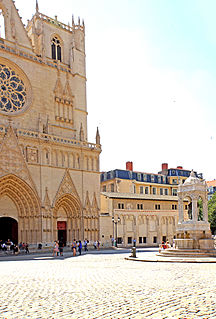
Gébuin was an archbishop of Lyon who served 1077 to 1082.
Guihomar V of Léon was a Viscount of Léon, son of Guihomar IV.
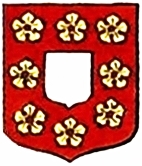
The "family of Tancarville" was of Norman stock, of likely Scandinavian descent, originating in the Pays de Caux, from that of the Viking Tancredus, companion of Rollo, in the conquest of northern France. Tancreds' progeny remaining closely tied to the royal family, becoming the hereditary Chamberlains of Normandie and of England, as well as many other crown offices. The family was known as being, "in the highest ranks of the Anglo-Norman aristocracy, the lords of Tancarville".

The Prieuré de l'Oiselière is a priory located at Saint-Planchers, near Granville, in France. Nestled in a valley bordering the watercourse that bears its name, surrounded by fortified walls and moats, its history dates back to the 12th century. It was a dependency of the abbots of Mont-Saint-Michel who organised the cultivation of the fields and the woods and collected taxes. It was also a local justice court.

Saint-Gabriel-Brécy Priory was a Benedictine priory 10 km from the coast between Caen and Bayeux. It is sited in the town of Saint-Gabriel-Brécy, Calvados, France. A 13th century gate-tower survives, with ogive vaulting on sculpted capitals. It was adjoined by a now-lost guesthouse. The cornice is sculpted with small three-point arches. The vaulted refectory dates to the late 13th century. A keep was built to serve as a prison in the 15th century, whilst the Renaissance-style courtroom was built towards the end of the 16th century. A dovecote is now lost.
Bishop Radbod (Radbodus) was a French prelate of the 11th century.
Norgod was bishop of Avranches from 990 to 1017-c.1022. Almost nothing is known about him, and his first appearance as bishop dates from the foundation of Fécamp, on 15 June 990. After that, he appears c. 1015 witnessing two charters with donations to Mont Saint-Michel, by Robert, Count of Mortain, and Gunnor, wife or Richard I. Finally, in 1017, he witnessed a charter by William of Volpiano concerning the privileges of the monks of Fruttuaria. He removed himself to Mont Saint-Michel soon after, where he finished his days as a monk. He died either on 14 October, either on 1026 or 1036.
Maugis was a Catholic cleric who bishop of Avranches in what is today France from 1017 to 1022.
Hugh was bishop of Avranches from 1028-c.1060. He was responsible for completing the most important parts of the cathedral, and took steps to reconstitute its holdings, securing donations from Robert I and William II.











